Top 5 Guided Grand Canyon Backpacking Tours

There are many ways to enjoy the Grand Canyon, but one of the most adventurous, immersive and meaningful is backpacking. This type of trip allows visitors to truly sink into the Grand Canyon experience by spending multiple days and nights below the rim. It is, however, potentially very dangerous (many people are rescued from the backcountry of the Canyon every year and sadly, some even lose their lives.) Going with experts is highly recommended for anyone who does not possess the experience, knowledge and/or equipment to responsibly and enjoyable embark on one of these adventures; or for anyone who wants to have an educational, premier adventure led by local experts.
Before we go deeper, you might be wondering who we are and why we’re asking you to trust us. Wildland Trekking is the #1 hiking and backpacking company in Grand Canyon National Park on Trip Advisor, Google and Trust Pilot. We’ve been guiding people into the Canyon since 2005 and have, in total, taken more than 40,000 people below the rim. We guide trips in the Corridor, which is the most popular and most developed section of the Park; and we take people far into the remote corners of the Park to Kanab Creek, Hermit Rapids, the Confluence, Thunder River and other amazing destinations. Along with guided backpacking trips, we also offer inn-based tours, camping-based tours, and guided day hikes.
Why Join a Guided Trip
There are many reasons to join a guided trip. One, already mentioned above, is increased safety. By going with expert guides, guests are able to relax and enjoy themselves knowing they’re hiking with someone who intimately understands the Canyon. The guide knows the route, where the water is, what time of day is the hottest, where shade can be found, when to start hiking, when to get to camp, what to do in an emergency, how to spot early signs of heat stroke and hyponatremia, they carry a satellite phone and robust first-aid kit…etc.
Another major reason is the knowledge you will gain. All Wildland Trekking guides are trained naturalists and can vastly increase your understanding of the geology, flora, fauna and history of the Canyon. This is a sometimes secondary motivation that after the trip is something guests enjoyed the most.
Being able to travel light without the equipment needed for a multi-day backpacking trip is a significant benefit, as are fantastic meals and not having to bother with nit picky details like permits, local transportation, route planning and menu planning.
Top Grand Canyon Backpacking Tours
| Trip | Difficulty | Days | Miles |
| Rim to Rim | Moderate | 4 | 24 |
| Grand Canyon Classic | Moderate | 3 | 17 |
| Hermit Loop | Moderate-Strenuous | 5 | 29 |
| Wonders of the Grand Canyon | Strenuous | 6 | 28 |
| Winter Rim to Rim to Rim | Moderate-Strenuous | 6 | 44 |
1. Rim to Rim Tour
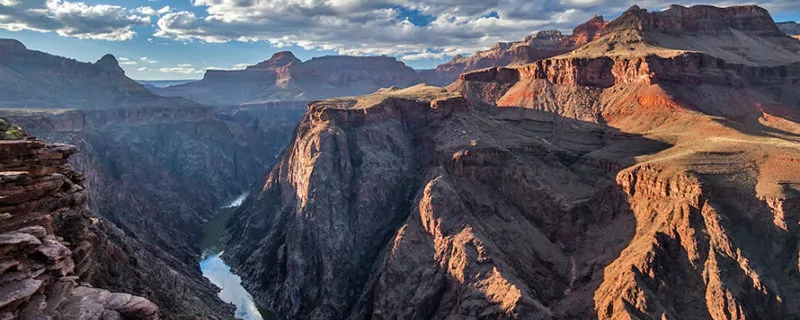
The Area
This world famous hike takes place in the “Corridor,” which is the route that connects the South Rim Village with the North Rim infrastructure at Grand Canyon Lodge and Bright Angel Point. The Corridor is a natural fault line (Bright Angel Fault) that causes breaks, or weaknesses, in the sheer cliffs. These weaknesses allowed walking paths, originally used by Native Americans, for unlikely routes in and out of the Canyon. Eventually, these ancient paths were converted into hiking trails by early pioneers like Ralph Cameron, and eventually adopted by the National Park Service.
The Corridor consists of three main trails: South Kaibab, North Kaibab and Bright Angel. These are also the most moderate trails that go into the inner Canyon and down to the Colorado River. Essentially all trails outside the Corridor are strenuous, rugged trails.
Trip Overview
The Rim to Rim in the Grand Canyon Tour begins in Flagstaff. From there we shuttle (local transportation included) to the North Rim where we begin hiking down the North Kaibab Trail. We take two days to reach Bright Angel Campground, which is near Phantom Ranch and the Colorado River. From there we follow Bright Angel Trail to Havasupai Garden Campground, then on day 4 we complete our thru-hike to the South Rim, where our shuttle back to Flagstaff is waiting for us.
Day by Day Itinerary
Day 1: Your guide will pick you up this morning at your hotel in Flagstaff, AZ and shuttle toward the North Rim. We will stop at Navajo Bridge en route, which is especially meaningful because it marks the beginning of the Grand Canyon and is a historic bridge we can walk across. Hundreds of feet above the Colorado River, the views are dizzying! We will enjoy breakfast at the bridge and then continue on to the North Rim Kaibab Trailhead. Our hike takes us from the forested North Rim quickly down to amazing viewpoints into the desert of the inner canyon. Our camp tonight is along the cool, refreshing waters of Bright Angel Creek. Total hike is 7 miles, 4100 feet elevation loss.
Day 2: Today we get an early start and continue down canyon. Our entire hike today follows Bright Angel Creek. We stop at Ribbon Falls, a beautiful waterfall that can wonderfully cool off anyone feeling too warm. Below Ribbon Falls we enter Bright Angel Box Canyon, which is a narrow, cliff-lined canyon carved out by Bright Angel Creek. Eventually we’ll come to Phantom Ranch and then our camp for the night, Bright Angel Campground. The Colorado River is just a 5 minute walk from camp, where we can enjoy a stunning sunset. Total hike is 7 miles, 1600 feet elevation loss.
Day 3: Another early start takes us along the Colorado River for 1.5 miles (beautiful walk!) to Pipe Creek, where we turn South and begin climbing up to Havasupai Garden. Today’s hike follows Pipe Creek and then Garden Creek, both lovely desert oases. At Havasupai Garden, which is shaded and relatively cool, we will set up camp and relax for a couple hours. In the evening we hike out do Plateau Point for a sunset dinner and one of the most amazing viewpoints in the Grand Canyon. Total hike is 4.5 miles, 1500 feet elevation gain.
Day 4: Today is our biggest uphill hike. We again start early and begin hiking up the Bright Angel Trail to the famous switchbacks that carry us up the final 2500 feet to the South Rim. The views get bigger and bigger as we ascend, and by the top we can see nearly our entire route as we look back across the Canyon. We meet up with our shuttle driver at the South Rim and shuttle back to Flagstaff. Total hike is 4.8 miles, 3000 feet elevation gain.
When to do this Trip
We offer the Rim to Rim Backpacking Tour from May 12 through mid November. The North Rim is closed half the year and opens on May 15. It closes again after the first significant snowfall on the North Rim after October 15, which most often occurs after mid November.
Summer months – June, July and August – can be extremely hot in the Canyon with temperatures reaching into the 105+ degrees fahrenheit range in the shade. But this route follows water much of the way and is an excellent summer trip despite the high summer temps.
Learn More about this Trip!
You can learn more about this trip by going to the Rim to Rim Tour page. Find out dates, cost, what’s included (almost everything!), what’s not included and more. You can always call us as well at 800-715-HIKE (4453) to learn more!
2. Grand Canyon Classic
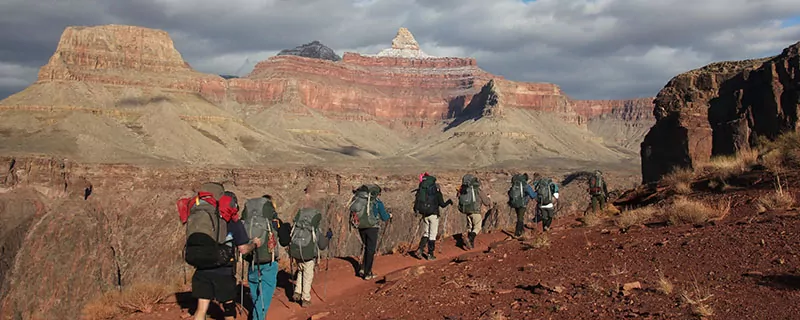
The Area
This trip is, like the Rim to Rim above, in the Corridor section of Grand Canyon National Park. However, unlike the Rim to Rim, this trip follows trails on the south side of the Canyon creating a loop instead of a thru-hike. We camp on the north side, but only 1/4 mile away from the Colorado River.
Trip Overview
This amazing and extremely popular backpacking trip begins and ends in Flagstaff, Arizona and is a loop hike off the South Rim. It follows the South Kaibab Trail down and Bright Angel Trail back up, after spending a night at the bottom of the Canyon near the Colorado River, and a night at Havasupai Garden near spectacular Plateau Point. Being only 3 days in length, this adventure packs a tremendous punch into a relatively short amount of time.
Day by Day Itinerary
Day 1: Your guide will swing by your hotel and pick you up in Flagstaff to begin our shuttle to the South Rim. We’ll catch a national park shuttle to the South Kaibab Trailhead. Our trek begins on the South Kaibab Trail, which takes us down past dizzying views and drop-offs at Ooh Aah Point, Cedar Ridge, Skeleton Point and finally to the Black Bridge over the Colorado River. Our camp at Bright Angel Campground is across the bridge on the north side of the Canyon along the enchanting waters of Bright Angel Creek. Total hike is 7.5 miles, 4800 feet elevation loss.
Day 2: Today we’ll get started to hot coffee and tea and a feast of a breakfast, then break camp and head out on the Bright Angel Trail. It crosses the Colorado River on the Silver Bridge, then parallels the River for approximately 1.5 miles before turning up the Pipe Creek Drainage. We’ll hike along the creek and then up the infamous Devils Corkscrew to Garden Creek, and a bit farther to our camp at Havasupai Garden Campground. Tonight we’ll hike out to Plateau Point for a sunset dinner at one of the best viewpoints in the Canyon. Total hike is 4 miles, 1500 feet elevation gain.
Day 3: Today we break camp at Havasupai Garden and begin our final hike out on the Bright Angel Trail. It begins gradually moving us uphill and then ascends a dramatic, 2500 ft series of switchback to the South Rim. We’ll meet up with our shuttle driver and make our way back to Flagstaff. Total hike is 4 miles, 3000 feet elevation gain.
When to do this Trip
This trip is excellent in all seasons but summer. Winter is a wonderful time to do this trip and have the Canyon much to yourself. Temperatures in winter are potentially chilly inside the Canyon, and can be quite cold on the rims, but overall it’s a lovely time to hike the Canyon. Spring and Fall are the peak seasons for this trip, particularly March/April and September/October. May is still a great time, but can start getting quite hot. Summer is blacked out because of high midday temperatures and a lack of shade and water on the South Kaibab Trail.
Learn More About This Trip!
You can learn more about this trip by going to the Grand Canyon Classic page. Find out dates, cost, what’s included (almost everything!), what’s not included and more. You can always call us as well at 800-715-HIKE (4453) to learn more!
3. Hermit Loop Backpacking Trip
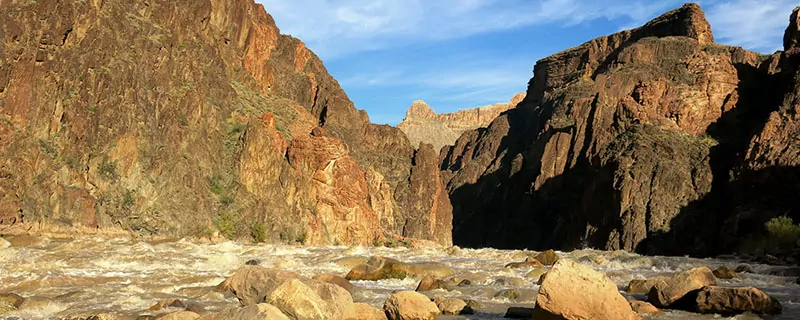
The Area
The Hermit Loop Backpacking Trip begins on the Bright Angel Trail, which is Grand Canyon National Park’s most popular hiking trail. However, most of this trip is on the Tonto Plateau west of the Corridor in a quiet and remote part of the Canyon. The Tonto Trail, which runs along the Tonto Plateau for the length of the Canyon, offers solitude, pristine wilderness and breathtaking views.
Trip Overview
We call this trip a loop, but the hike itself is a thru-hike on which we never backtrack and always are discovering new scenery. We begin down the Bright Angel Trail, which can be quite busy, but we quickly leave the crowds behind and make our way west to an amazing campsite at Horn Creek. Then we continue west for 4 days, spending time at a variety of campsites, visiting powerful rapids on the Colorado River, and deeply appreciating the absolutely world-class scenery we are seeing. This trip is arguably the most scenic backpacking trip in the Grand Canyon.
Day by Day Itinerary
Day 1: Your guide picks you up in Flagstaff and we make our way to the South Rim of the Grand Canyon. Our hike starts on the Bright Angel Trail, where we descend about 4.5 miles to Havasupai Garden, and then hang a left to the west. Another 2 miles across a vast, open plateau brings us to Horn Creek, where we spend the night tonight. Total hike is 7 miles, 3060 feet elevation loss.
Day 2: We break camp and continue west on the Tonto Trail. The views are outstanding as we are hiking on the Tonto Plateau, which is a broad, flat bench that allows for stunning views in all directions. We’ll set up camp tonight at Monument Creek, a quaint desert oasis with a trickling, spring-fed creek. Total hike is 9 miles, 800 feet elevation gain.
Day 3: We layover at Monument Creek on Day 3 and day hike to Granite Rapids on the Colorado River, which is a dramatic, furious rapid. If we’re lucky we’ll watch some rafting groups try to make it through the rapid upright while we enjoy a picnic lunch from the white sand beach along the river. Total hike is 3 miles, 1000 feet elevation loss/gain.
Day 4: Today we break camp and move to Hermit Creek, which is another charming desert oasis. We’ll set up camp and then day hike to Hermit Rapids on the Colorado River. This rapid, too, is a serious one. The power coming off the river at this spot is something you’ll never forget. Total hike is 6.5 miles, 1200 feet elevation loss/gain.
Day 5: Today is our hike out back to the South Rim. We’ll break camp and get an early start. The Hermit Trail takes us up, up, up on fairly rugged terrain, past dizzying drop-offs, to Waldron Basin, where we’ll enjoy a picnic lunch in the shade of pinyon trees. This was a regularly-used hunting camp by the Native Americans who called the Canyon home for centuries. Our final ascent is on sun-bleached switchbacks through the Coconino Sandstone and Kaibab Limestone layers. Eventually we’ll make it to the South Rim, where we’ll relax in our shuttle back to Flagstaff. Total hike is 8 miles, 3400 feet elevation gain.
When to do this Trip
This trip is best in the spring and fall, particularly March through May, and September through November. However, winters can be quite nice if you’re up for chillier, but still quite moderate, temperatures. In the summer (June-August) this trip should be avoided.
Learn More About This Trip!
You can learn more about this trip by going to the Hermit Loop page. Find out dates, cost, what’s included (almost everything!), what’s not included and more. You can always call us as well at 800-715-HIKE (4453) to learn more!
4. Wonders of the Grand Canyon
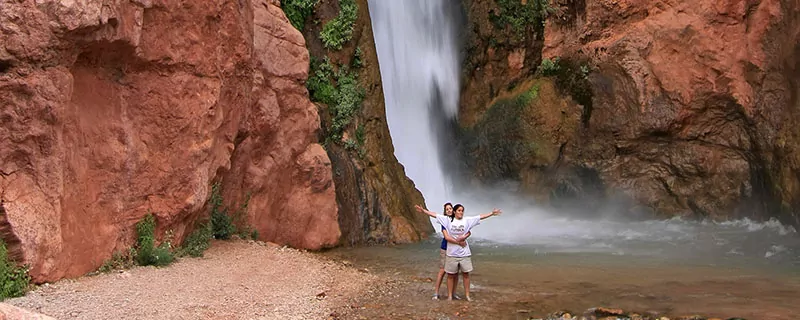
The Area
This trip takes place entirely on the north side of the Colorado River. We begin at a remote trailhead on the North Rim, make our way to the Colorado River, and then back to the North Rim. This area is remote, wild, and the hiking is generally quite strenuous.
Trip Overview
This trip is arguably the best backpacking adventure in Grand Canyon National Park. It has amazing features like a river exploding from the side of a cliff, dramatic views, canyon narrows, waterfalls, the Colorado River and more. The hike is also mostly a loop so there’s some, but very little, backtracking. This trip is very strenuous and, depending on water flows, can have exposed hiking near drop-offs. It is not one for the faint-hearted, but it’s an adventure you’ll never forget if you’re up for the challenge!
Day by Day Itinerary
Day 1: This guided Grand Canyon backpacking tour begins with pick up at your hotel in Flagstaff. We shuttle to our trailhead on the North Rim, which takes approximately 4 hours. Today’s hike drops us down to the Esplanade, which is a flat bench with pinyon and juniper trees but little water, so tonight is normally a dry camp. Total hike is 4 miles, 2200 feet elevation loss.
Day 2: Today we descend farther into the Canyon to a broad, scenic valley called Surprise Valley. We swing right (west) and into Deer Creek Valley, where we enjoy a gushing desert oasis and two plunging waterfalls. Total hike is 6 miles, 3200 feet elevation loss.
Day 3: Today we parallel the Colorado River past Tapeats Rapid to Tapeats Creek. We turn north into the Tapeats Creek Drainage and make our way to tonight’s camp along Tapeats Creek. This is a stunning canyon with cool, clear, spring-fed water and dramatic sinuous canyon features. We’ll set up camp and then hike up to Thunder Spring, which is the beginning of Thunder River – a river that literally explodes from the sheer face of a cliff, then runs briefly and melts into Tapeats Creek. It’s the world’s shortest river. Total hike is # miles, # feet elevation [gain loss].
Day 4: Today is a layover day to hike, explore and enjoy this spectacular place we’ve hiked into. We can hike up canyon and explore the wonders and beauty of Tapeats Creek then relax in camp for the afternoon.
Day 5: Today takes us back up toward the North Rim to Surprise Valley and the Esplanade, where we spend our final night. Total hike is 6 miles, 3000 feet elevation gain.
Day 6: Our final day of hiking takes us back from the Esplanade to the North Rim, where our shuttle back to Flagstaff awaits. Total hike is 5 miles, 2200 feet elevation gain.
When to do this Trip
This trip leaves from a remote trailhead on the North Rim, and while it is accessible before the North Rim of Grand Canyon National Park officially opens (May 15), variable snow levels can keep the roads blocked and the rivers running high well into April. For this reason, we offer this trip beginning in May, but not after May due to summer temperatures. Which leaves the fall… September, October and November are the best months for this trip – the North Rim roads are open, the creeks are running low, and summer temperatures have given way to the beautiful hiking weather of the Autumn months.
Learn More About This Trip!
You can learn more about this trip by going to the Wonders of the Grand Canyon page. Find out dates, cost, what’s included (almost everything!), what’s not included and more. You can always call us as well at 800-715-HIKE (4453) to learn more!
5. Winter Rim to Rim to Rim
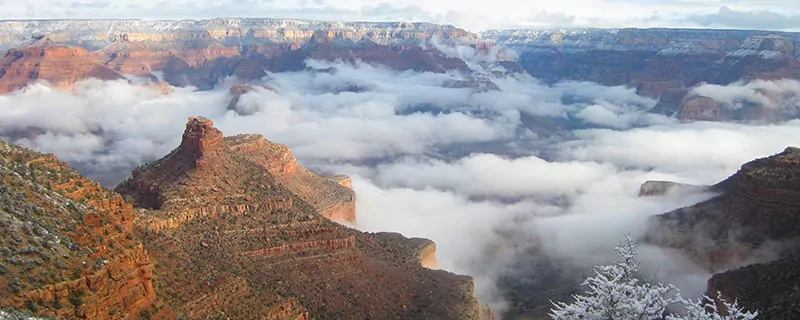
The Area
Like the main Rim to Rim, this trip also follows the main Corridor Trails. This one however covers all three of the Corridor Trails: South Kaibab, North Kaibab, and Bright Angel. It begins on the South Rim, touches the North Rim, and returns to the South Rim.
Trip Overview
The North Rim of Grand Canyon National Park closes at the first significant snowfall after October 15 every year (usually in mid November), and it opens again on May 15 of the following year. For this reason the standard Rim to Rim Backpacking Trip is not accessible year round. Which leaves us with the Winter Rim to Rim to Rim Backpacking Trip, a phenomenal option! It offers more than the standard Rim to Rim because we descend from the South Rim on the South Kaibab Trail, which has arguably the best views in the Corridor. Then we ascend the North Kaibab Trail to the North Rim on a day hike from Cottonwood Campground, and return to the South Rim via the Bright Angel Trail.
Recommended Day by Day Itinerary
Day 1: Your guide will pick you up at your hotel in Flagstaff and we’ll begin our shuttle to the South Rim. We’ll park the vehicle and catch a national park shuttle from the Backcountry Information Center to the South Kaibab Trailhead. Our trek starts on the South Kaibab Trail, which takes us down past dizzying views and drop-offs at Ooh Aah Point, Cedar Ridge, Skeleton Point and finally to the Black Bridge over the Colorado River. Our camp at Bright Angel Campground is across the bridge on the north side of the Canyon along the enchanting waters of Bright Angel Creek.Total hike is 7.5 miles, 4800 feet elevation loss.
Day 2: We’ll break camp at Bright Angel and begin hiking up the North Kaibab Trail along Bright Angel Creek. Our route takes us through Bright Angel Box Canyon, a narrow hall of cliffs thousands of feet high. We’ll visit Ribbon Falls, a wonderful waterfall whose mineral deposits have created a 30-feet-high travertine mound and a short walk takes us behind the waterfall for amazing photography. We’ll continue up the trail to Cottonwood Campground, where we’re going to spend the next two nights. Total hike is 7 miles, 1600 feet elevation gain.
Day 3: Today is our “summit bid” when we go for the North Rim. Our hike follows Bright Angel Creek then splits off and heads up a deep, long side canyon past Roaring Springs and Supai Tunnel. The North Kaibab Trail can be quite exciting in this area, with drop-offs hundreds of feet high just off the edge of the trail (the trail is 4-5 feet wide at the narrowest, so don’t be overly alarmed!). Our normal turnaround point is Coconino Overlook, where we can see the San Francisco Peaks in the distance, towering over Flagstaff. We’ll fill up our tanks with a great picnic lunch and turn back toward camp. Total hike is 14 miles, 4100 feet elevation gain/loss.
Day 4: Today we head back down the North Kaibab Trail to Bright Angel Campground. Total hike is 7 miles, 1600 feet elevation loss.
Day 5: That’s it for backtracking! Today we head out on the Bright Angel Trail, which crosses the Colorado River on the Silver Bridge, then contours the River for approximately 1.5 miles before turning south along Pipe Creek. We’ll hike along the Pipe Creek and then up the infamous Devils Corkscrew to Garden Creek, and a bit farther to our camp at Havasupai Garden Campground. Tonight we’ll hike out to Plateau Point for a sunset dinner at one of the best viewpoints in the Canyon. Total hike is 4 miles, 1500 feet elevation gain.
Day 6: Today we break camp at Havasupai Garden and begin our final hike out on the Bright Angel Trail. It begins gradually moving us uphill and then ascends a dramatic, 2500 ft series of switchback to the South Rim. We’ll meet up with our shuttle driver and make our way back to Flagstaff. Total hike is 4 miles, 3000 feet elevation gain.
When to do this Trip
This trip is fantastic in November, December, January and February. We do not offer it March through October.
Learn More About This Trip!
You can learn more about this trip by going to the Winter Rim to Rim to Rim Backpacking Trip page. Find out dates, cost, what’s included (almost everything!), what’s not included and more. You can always call us as well at 800-715-HIKE (4453) to learn more!
More Important Things to Know
Permits and When to Register
Grand Canyon National Park issues backpacking permits for guided trips and private parties all at the same time, 4 months in advance on the first of the month (see dates below.) The process is a lottery and all submissions, guided groups and private groups, are entered into the same lottery. It’s important to register for your backpacking trip before permits become available for that month, and Wildland Trekking offers a 5% early registration discount for registering before the permit process.
The dates permits are issued for each month are as follows:
- January trips – deadline to register: before September 1
- February trips – deadline to register: before October 1
- March trips – deadline to register: before November 1
- April trips – deadline to register: before December 1
- May trips – deadline to register: before January 1
- June trips – deadline to register: before February 1
- July trips – deadline to register: before March 1
- August trips – deadline to register: before April 1
- September trips – deadline to register: before May 1
- October trips – deadline to register: before June 1
- November trips – deadline to register: before July 1
- December trips – deadline to register: before August 1
Grand Canyon confirms trip dates in the middle of the month, so guests know their dates are confirmed normally approximately 3.5-4 months in advance.
What’s Included?
Wildland Trekking trips are all-inclusive, which is rare in the adventure travel industry. Many companies charge rental fees for items such as sleeping bags, sleeping pads, tents and backpacks. With Wildland, you can relax and know we have you covered.
What’s included is:
- Multi-day backpack (Osprey or Deuter)
- Trekking poles (Black Diamond or Leki)
- Tent (1p, 2p, 3p or 4p depending on your group; Kelty, Big Agnes or Sierra Designs)
- Sleeping bag (professionally laundered after every trip)
- Inflatable sleeping pad
- Local transportation from Flagstaff to the trailhead and back
- Delicious meals prepared by your guide, to include breakfast Day 1 through lunch the final day
- First aid and safety equipment, including a satellite communicate device
- Backpacking permits
- National park entrance fees
What’s Not Included?
There are a couple items and category of items that are not included.
What’s not included is:
- Clothing
- Footwear
- Personal items
- Water container(s) – 3 1-liter water bottles or a combination of water bladder and water bottles to equal 3 total liters
- Headlamp or flashlight and extra batteries
- Gratuity for your guide (industry recommendation is 10-20% of trip cost)
Recommended Packing and Clothing List
- Solid high-top or low-top hiking shoes or boots
- 3-4 pairs wool or synthetic hiking socks
- 2-3 cotton t-shirts (yep, cotton! good for keeping cool in the desert)
- 1-2 long-sleeve fleece shirts
- Waterproof/breathable rain jacket and pants
- 2-3 pairs nylon hiking shorts and/or pants
- 2-3 pairs extra underwear
- Warm hat in winter months
- Down or synthetic insulated jacket in the winter months
- Fleece or wool gloves in winter months
- Sunscreen
- Sunglasses
- Sunhat
- Camera
- Personal hygiene items
Are You Ready for a Grand Canyon Backpacking Trip?
Most likely your trip – because of the permit system – is at least 4-5 months away. Even if it’s not, there’s a good chance you can be ready when the time comes if you train. If you’re healthy and in reasonably good shape, then with some training you will most likely do great.
The question to ask is not whether you can DO a trip, it’s whether you can ENJOY a trip. There’s a tremendous difference. Some people can get through it but it feels like a survival game and by the end of it they maybe glad they did it, but don’t want to do it again. That situation only arises when someone hasn’t prepared and trained for their trip. To enjoy a trip in the Canyon, you must be prepared.
To prepare, we recommend beginning your training as early as possible. You want to train with 25-30 pounds loaded into a backpack at least once per week over 4-6 miles of walking. And it’s important to get exercise 3-4 times per week in other ways, such as working out on the Stairmaster or climbing stairs or even running or swimming.
Eat right, exercise, train with weight on your back, stretch and start getting excited!
Wildland Trekking Hiking Adventures
As the world’s premier hiking and trekking company, Wildland believes in connecting people to fantastic environments in amazing ways. Grand Canyon National Park offers an array of incredible hiking and trekking experiences. Wildland Trekking provides 21 different multi-day hiking and backpacking adventures in the Canyon. Read more about our Grand Canyon trips.
To learn more about our guided backpacking trips and all of our award-winning hiking vacations, please visit our website or connect with one of our Adventure Consultants: 800-715-HIKE




